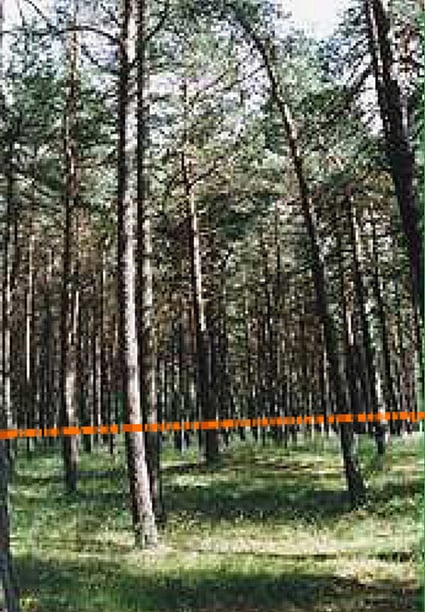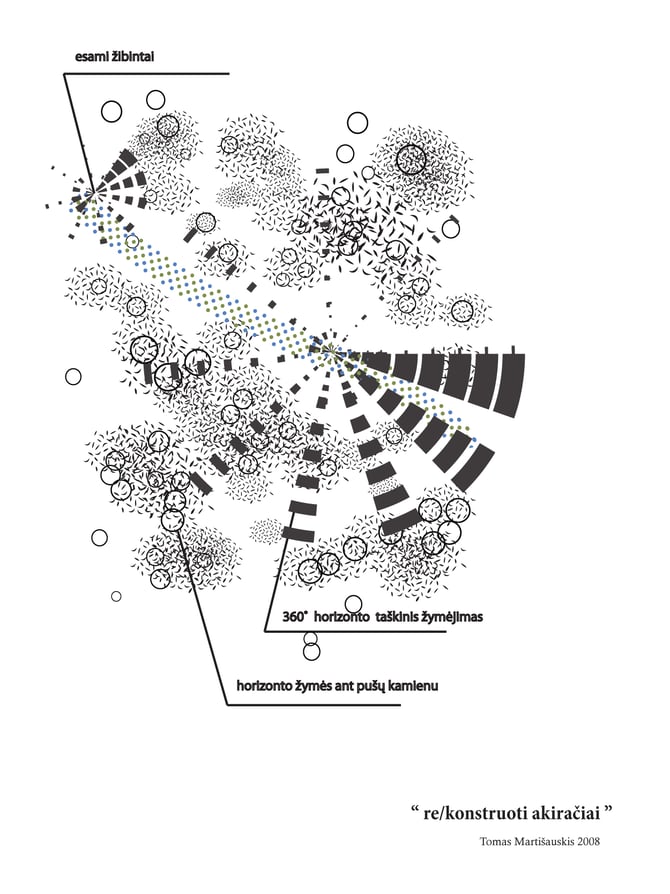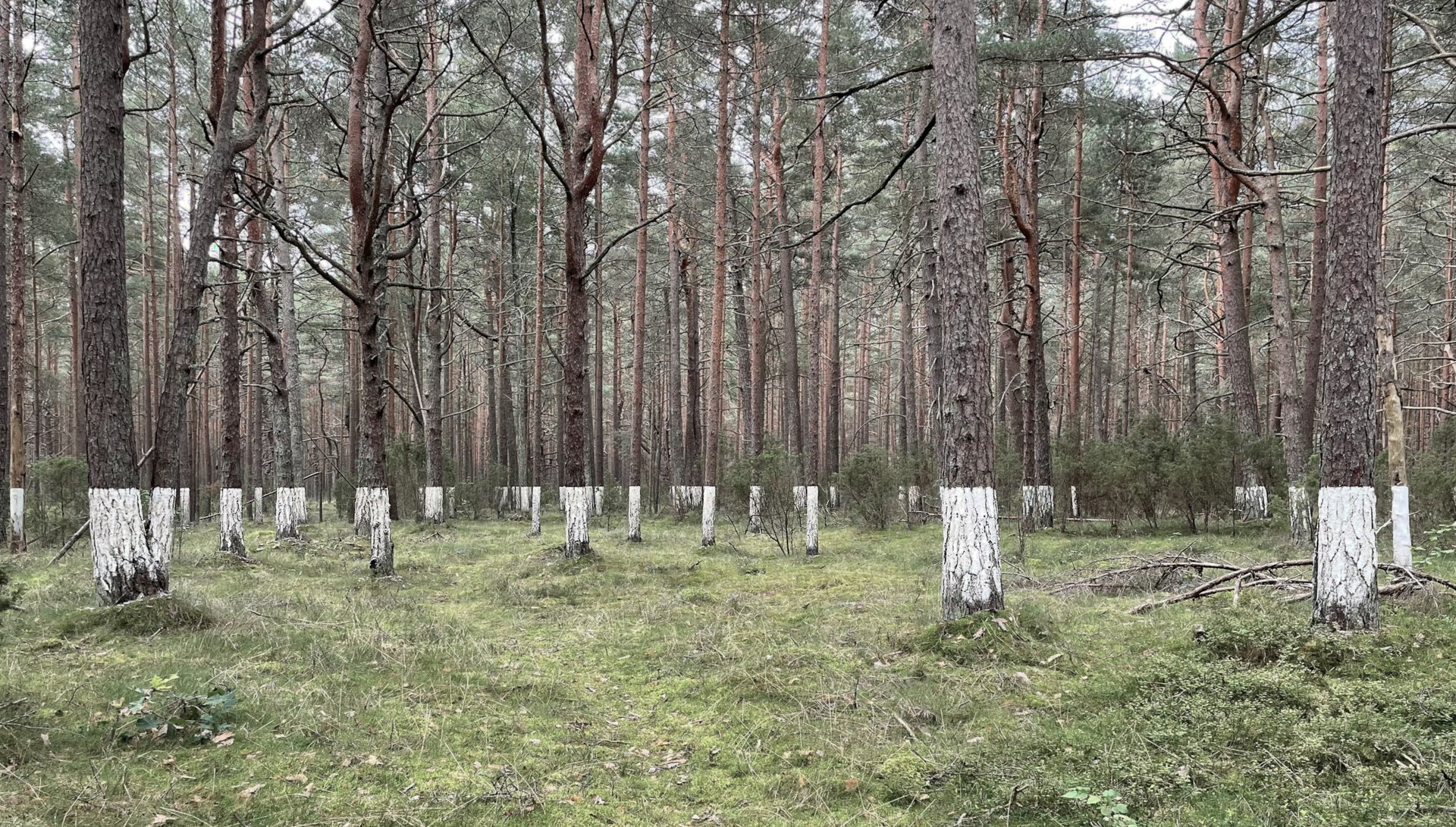
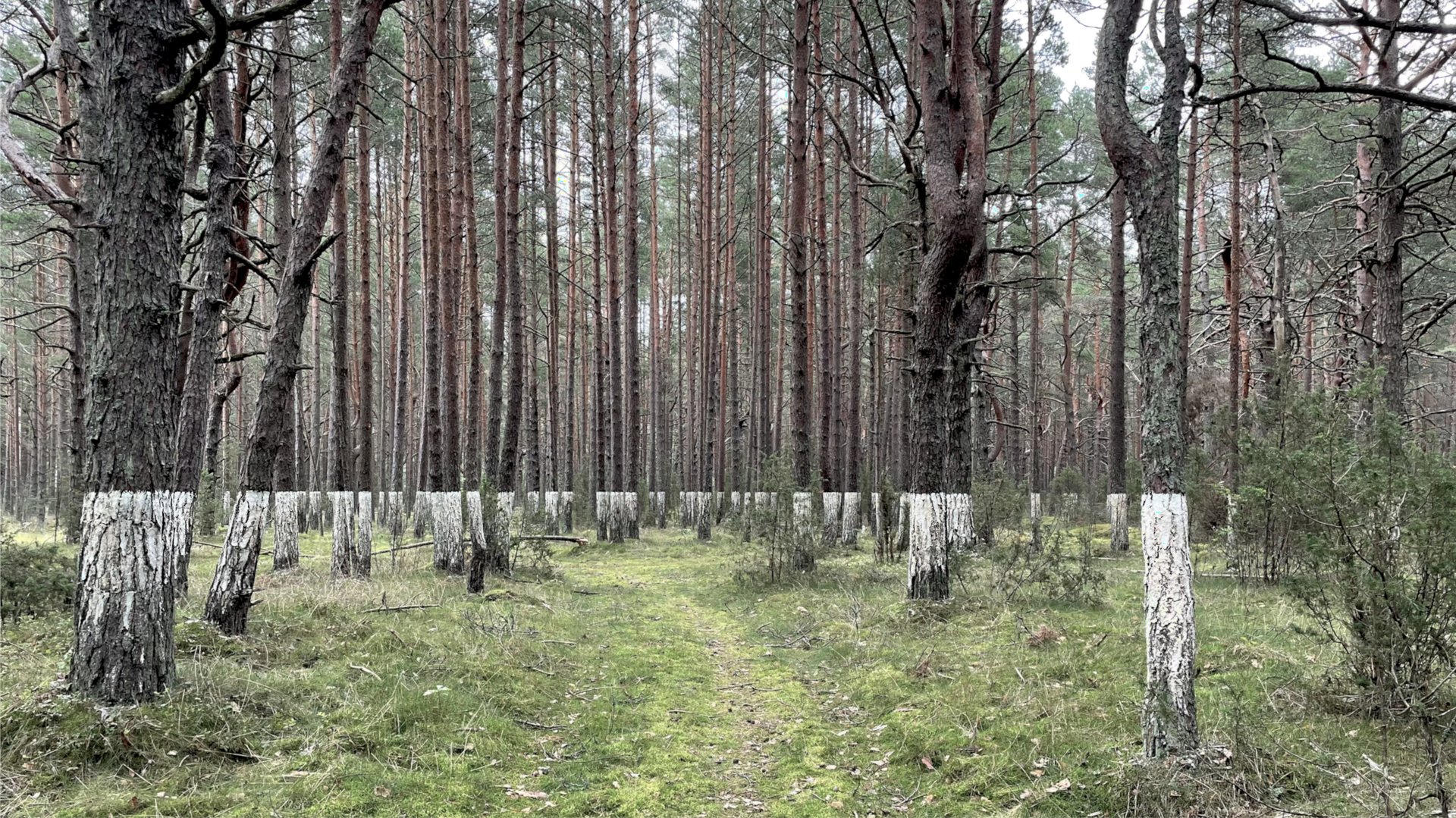
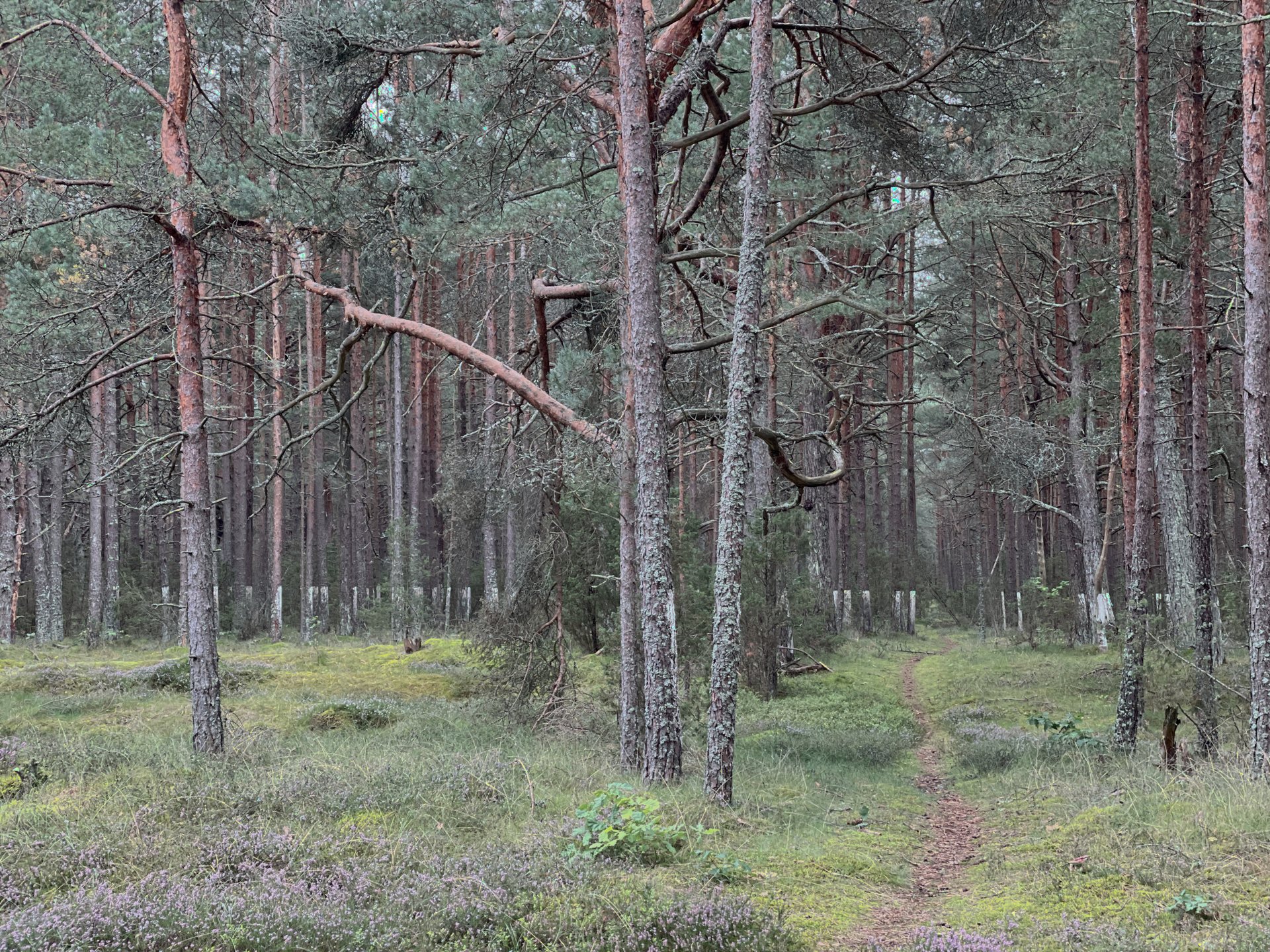
Title: Appropriate
Year of Creation: 2023
Materials and Technique: Slaked lime, pine tree trunks (150 units)
Dimensions: Variable size, diameter 100m
Category: Site-specific installation
Part of a Series: Reconstructed
Location: Šventoji, Palanga City, Lithuania
Concept Description: Through an anamorphic optical illusion, this work explores territorial appropriation and the shifting boundaries between the natural and constructed environments.
Pavadinimas: Nusavinti
Sukūrimo metai: 2023
Medžiagos ir technika: Gesintos kalkės, pušų kamienai ~150 vienetų
Matmenys: Dydis kintantis, skersmuo 100 m
Kategorija: Įvietinta instaliacija
Dalies pavadinimas: Re/konstruoti
Vieta: Šventoji, Palangos miestas, Lietuva
Koncepcijos aprašymas: Per anamorfines optines iliuzijas tyrinėjama teritorinė apropriacija ir kintančios ribos tarp gamtos ir sukurtos aplinkos.
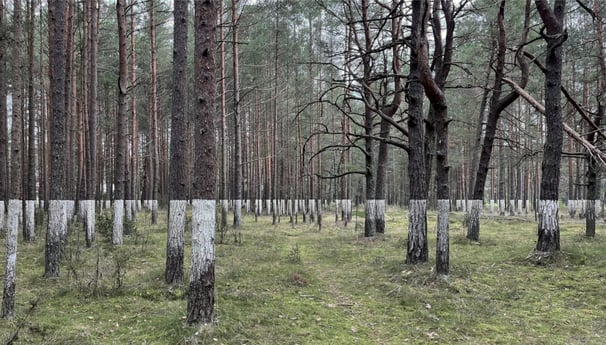



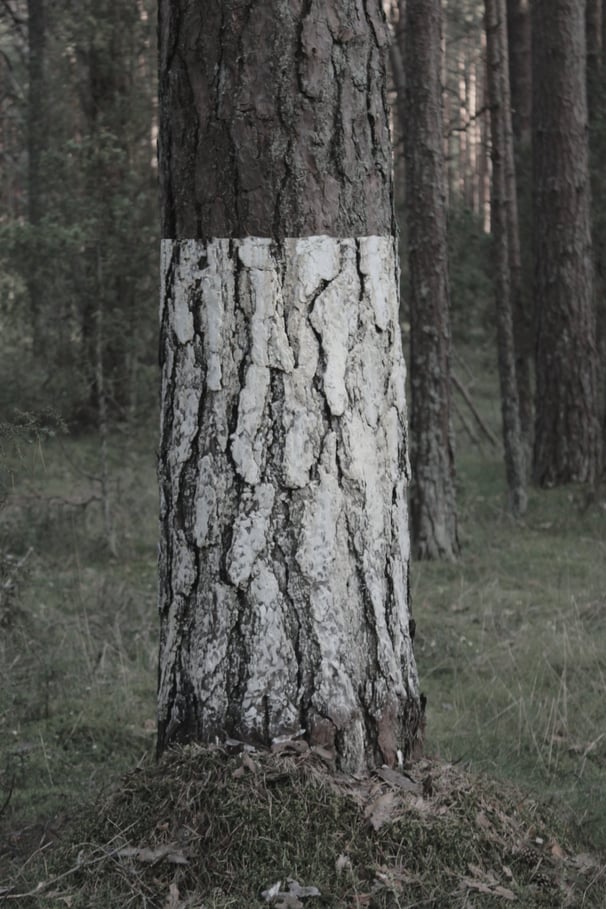
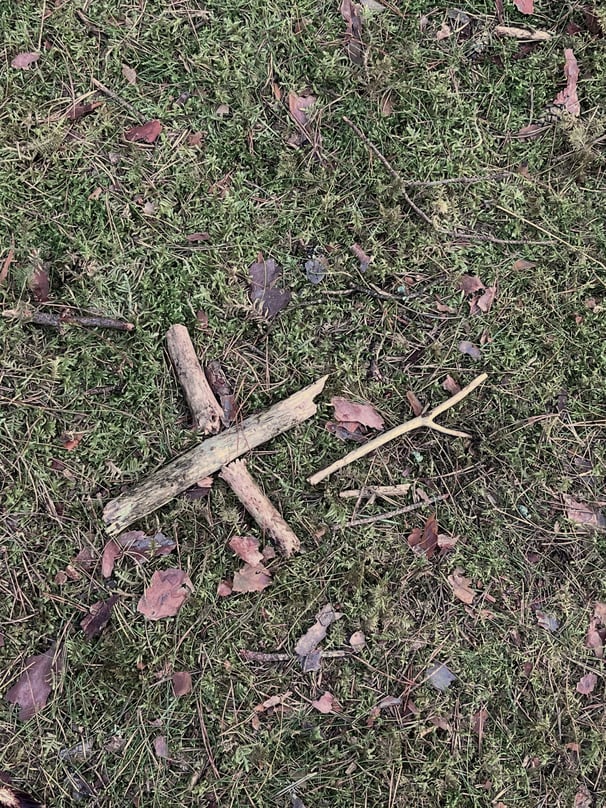






Site-specific installation 'Appropriate' by Tomas Martišauskis in Šventoji
Artist Tomas Martišauskis invites to a point with specific coordinates in the pinewood in the locality of Šventoji (Lithuania), where he presents the site-specific installation Appropriate, which can be viewed live until the lime mixture naturally washes off the tree trunks.
The horizon might well be one of the few elements of the environment that hasn’t changed over the ages. Just as inspiring and banal, it was observed millennia ago and still is today. The horizon line shaped the concepts of time and space, helped sailors estimate the ships’ locations, and continues to be the metaphor for travel destinations and ambitions. Precisely this silent and mute distant horizontal is claimed to have enabled the domination of the West and its concepts, and to have served as the instrument of colonial conquests. Having entrenched objective standpoints, the horizon introduced mathematical prognostics and the illusion of stability, becoming a hostage of the truth it so confidently proclaimed. No matter how constant the horizon could be or appear, though, its stability depends on the observer and the base they stand on. Today the status of this dominant visual paradigm is changing. The horizon line quivers because of contested outdated ideas, it is cut by the rattling, constantly shaped landscape, while the status of the human looking into the distance as the centre of the world depreciates.
Taking into account these shifting orientational states and evaluations of stability, the artist Tomas Martišauskis approaches the horizon as a kind of portable and assemblable material. In his site-specific installation Appropriate, the artist offers a look at the usually inaccessible open or even infinite-panoramic horizon. Having painted more than 150 pine trunks with lime mixture in a replanted storm-affected pinewood in the locality of Šventoji, Martišauskis has created a territory of nearly a hundred metres in diameter, in the middle of which the viewer can stand in a marked spot and see the painted areas of the trees blend into a continuous horizon line. Based on the anamorphic (from Greek anamorphōsis, “transformation”) composition principle, the installation functions as an optical illusion constructed using a rotary laser level. Such spatial categories as proximity and distance temporarily coalesce here, making the visible image flat, the surface fictional, and the world a poetic puzzle.
Raising the artificial horizon line to the eye level of an average human height, the artist turns the installation into a kind of fata morgana, an optical phenomenon that makes distant objects appear suspended in the air due to specific light refraction. Finally, to see this deceptive sight, the viewer must stand in a predetermined precise position. Although invited to the very centre of the installation, the observer is in a certain sense ‘imprisoned’ in it, their individuality and the freedom of alternative observation choice is appropriated. This shade of meaning complements the multifaceted title of the work, Appropriate, which can be both a verb and an adjective.
Critically reflecting on the problem of territory appropriation, the artist uses subtle marking to expose the human interference into and desire to ‘arrange’ and construct the environment that may not even be our property. The artist applies the trunk bleaching procedure, usually employed for garden fruit trees, to forest pines, thus upsetting the order between ‘domesticated’ and ‘wild’, garden and forest trees, the ‘owned’ and the ‘appropriated’. With this gesture, used in gardening to protect the tree bark from pests and other harmful factors, Martišauskis proposes a slightly different semantics of forest tree marking, dissociated from logging meanings and at least in this case capable of acting as a protection of observing pines from a distance.
The artist has recreated this project after fifteen years. The first version of the work was presented at the International Thomas Mann Festival in Nida in 2008. Due to environmental protection requirements, the visually somewhat different installation was displayed only for several days. The new version can be viewed live until the lime mixture naturally washes off the tree trunks, or online.
Įvietinta Tomo Martišauskio instaliacija „Nusavinti“ Šventosios miške
Šventosios gyvenvietės miške veikia Tomo Martišauskio įvietinta instaliacija „Nusavinti”.
Horizontas, ko gero, yra vienas iš nedaugelio per amžius nekintančių aplinkos dėmenų. Toks pats įkvepiantis ir banalus jis stebėtas prieš tūkstantmečius ir šiandien. Horizonto linija formavo laiko ir erdvės sampratas, jūrininkams padėjo apskaičiuoti laivų padėtis, o šiandien tebeveikia kaip kelionės tikslų ir ambicijų metafora. Teigiama, kad būtent ši tyli ir nebyli tolumos horizontalė įgalino Vakarų ir jų išrastų sąvokų dominavimą bei tapo įrankiu kolonialistiniams užkariavimams. Įtvirtinęs objektyvias nuostatas, horizontas įvedė matematinį prognozavimą, stabilumo iliuziją ir tapo tiesos, kurią taip užtikrintai skelbė, įkaitu. Tačiau kad ir koks pastovus horizontas bebūtų ar atrodytų, jo stabilumas priklauso nuo stebėtojo ir pagrindo, ant kurio jis stovi. Šiandien šios dominuojančios vizualinės paradigmos statusas keičiasi. Horizonto linija virpa dėl iš pamatų judinamų pasenusių idėjų, ją karpo triukšmingo, nuolat formuojamo kraštovaizdžio elementai, o į tolį žvelgiančio žmogaus kaip pasaulėžiūros centro statusas nuvertėja.
Atsižvelgdamas į šias kintančias orientacines būkles ir stabilumo vertinimus, menininkas Tomas Martišauskis į horizontą žvelgia kaip į savotišką kilnojamą ir sukonstruojamą materiją. Įvietintoje instaliacijoje „Nusavinti“ menininkas siūlo pažvelgti į paprastai realybėje neegzistuojantį atvirą, o gal net begalinį-panoraminį horizontą. Po audros atsodintame Šventosios gyvenvietės miške kalkių mišiniu nudažydamas daugiau nei 150 pušų kamienų, T. Martišauskis suformuoja kone šimto metrų skersmens teritoriją, į kurios vidurį specifiniame taške atsistojęs žmogus gali išvysti į vieną nepertraukiamą horizonto liniją susijungiančius nudažytų medžių plotus. Anamorfinės (gr. anamorphosis – formos iškreipimas) kompozicijos principu sukurta instaliacija veikia kaip rotacinio lazerio spindulio pagalba sukonstruota optinė iliuzija. Tokios erdvinės kategorijos kaip artumas ir atstumas čia trumpam suvienodėja, paversdamos matomą vaizdą plokščiu, paviršių fiktyviu, o pasaulį – poetišku rebusu.
Dirbtinio horizonto liniją pakeldamas iki vidutinio ūgio žmogaus akių lygio, menininkas patį reiškinį paverčia savotišku fata morgana – optiniu fenomenu, kai dėl specifiškai lūžtančios šviesos tolumoje esantys objektai atrodo tarsi pakibę. Galų gale tam, kad ši apgaulinga regimybė būtų pamatyta, iš žiūrovo reikalaujama užimti iš anksto nustatytą tikslią padėtį. Nors ir kviečiamas į patį instaliacijos centrą, žmogus savotiškai jame „įkalinamas“, nusavinama jo individualumo ir alternatyvaus stebėjimo pasirinkimo laisvė. Ši prasmė papildo daugialypį kūrinio pavadinimą „Nusavinti“, veikiantį ir kaip veiksmažodis, ir kaip būdvardis.
Kritiškai atliepdamas teritorijų nusavinimo problematiką, menininkas subtiliu ženklinimu parodo žmogiškąjį kišimąsi ir norą „sutvarkyti“ bei sukonstruoti jam galbūt net nepriklausančią aplinką. Įprastai sodo vaismedžiams naudojamą kamienų balinimo procedūrą menininkas pritaiko miške augančioms pušims, taip sumaišydamas tvarką tarp „prijaukintų“ ir „laukinių“, sodo ir miško medžių, tarp to, kas yra „savi“, o kas „nusavinti“. Pasinaudodamas šiuo gestu, kuriuo sodininkystėje siekiama apsaugoti medžių žievę nuo kenkėjų ir kitų žalingų veiksnių, Martišauskis pasiūlo kiek kitokią miško medžių ženklinimo semantiką, atitolintą nuo kirtimo reikšmių ir bent jau šiuo atveju galinčią suveikti kaip pušų stebėjimo per atstumą apsauga.
Šį projektą menininkas atkuria po penkiolikos metų pertraukos, kai 2008-aisiais Nidoje vykusiame tarptautiniame Thomo Manno festivalyje buvo pristatyta pirmoji šio kūrinio versija. Dėl aplinkosauginių reikalavimų kiek kitokiais vizualiniais sprendimais išpildyta instaliacija buvo eksponuojama vos kelias dienas. Naująją jos versiją galima apžiūrėti gyvai tol, kol kalkių mišinys natūraliai nubluks nuo medžių kamienų, arba virtualiai.
To view the 360° image, simply drag with your mouse or use a touch screen to move in all directions.
